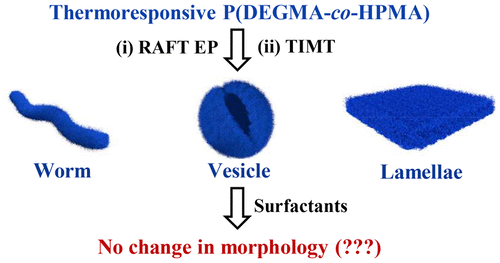当前位置:
X-MOL 学术
›
ACS Macro Lett.
›
论文详情
Our official English website, www.x-mol.net, welcomes your
feedback! (Note: you will need to create a separate account there.)
Overcoming Surfactant-Induced Morphology Instability of Noncrosslinked Diblock Copolymer Nano-Objects Obtained by RAFT Emulsion Polymerization
ACS Macro Letters ( IF 5.1 ) Pub Date : 2018-01-10 00:00:00 , DOI: 10.1021/acsmacrolett.7b00978 Nghia P Truong 1 , Cheng Zhang , Tuan A H Nguyen , Athina Anastasaki 2 , Morgan W Schulze 2 , John F Quinn 1 , Andrew K Whittaker , Craig J Hawker 2 , Michael R Whittaker 1 , Thomas P Davis 1, 3
ACS Macro Letters ( IF 5.1 ) Pub Date : 2018-01-10 00:00:00 , DOI: 10.1021/acsmacrolett.7b00978 Nghia P Truong 1 , Cheng Zhang , Tuan A H Nguyen , Athina Anastasaki 2 , Morgan W Schulze 2 , John F Quinn 1 , Andrew K Whittaker , Craig J Hawker 2 , Michael R Whittaker 1 , Thomas P Davis 1, 3
Affiliation

|
RAFT emulsion polymerization techniques including polymerization-induced self-assembly (PISA) and temperature-induced morphological transformation (TIMT) are widely used to produce noncrosslinked nano-objects with various morphologies. However, the worm, vesicle and lamellar morphologies produced by these techniques typically cannot tolerate the presence of added surfactants, thus limiting their potential applications. Herein we report the surfactant tolerance of noncrosslinked worms, vesicles, and lamellae prepared by RAFT emulsion polymerizations using poly(di(ethylene glycol) ethyl ether methacrylate-co-N-(2-hydroxypropyl) methacrylamide) (P(DEGMA-co-HPMA)) as a macromolecular chain transfer agent (macro-CTA). Significantly, these P(DEGMA-co-HPMA) nanoparticles are highly stable in concentrated solutions of surfactants (e.g., sodium dodecyl sulfate (SDS)). We also demonstrate that the surfactant tolerance is related to the limited binding of SDS to the main-chain of the P(DEGMA-co-HPMA) macro-CTA constituting the particle shell. This work provides new insight into the interactions between surfactants and thermoresponsive copolymers and expands the scope of RAFT emulsion polymerization techniques for the preparation of noncrosslinked and surfactant-tolerant nanomaterials.
中文翻译:

克服 RAFT 乳液聚合获得的非交联二嵌段共聚物纳米物体表面活性剂诱导的形态不稳定性
RAFT乳液聚合技术包括聚合诱导自组装(PISA)和温度诱导形态转变(TIMT)被广泛用于生产具有各种形态的非交联纳米物体。然而,由这些技术产生的蠕虫、囊泡和层状形态通常不能耐受添加的表面活性剂的存在,从而限制了它们的潜在应用。在这里,我们报告了使用聚(二(乙二醇)乙醚甲基丙烯酸酯-co-N-(2-羟丙基)甲基丙烯酰胺)(P(DEGMA-co-HPMA)通过 RAFT 乳液聚合制备的非交联蠕虫、囊泡和薄片的表面活性剂耐受性。 )) 作为大分子链转移剂 (macro-CTA)。值得注意的是,这些 P(DEGMA- co-HPMA) 纳米颗粒在表面活性剂(例如十二烷基硫酸钠 (SDS))的浓缩溶液中高度稳定。我们还证明了表面活性剂耐受性与 SDS 与构成颗粒壳的 P(DEGMA- co -HPMA) 大分子 CTA 主链的有限结合有关。这项工作为表面活性剂和热响应共聚物之间的相互作用提供了新的见解,并扩大了 RAFT 乳液聚合技术用于制备非交联和表面活性剂耐受性纳米材料的范围。
更新日期:2018-01-10
中文翻译:

克服 RAFT 乳液聚合获得的非交联二嵌段共聚物纳米物体表面活性剂诱导的形态不稳定性
RAFT乳液聚合技术包括聚合诱导自组装(PISA)和温度诱导形态转变(TIMT)被广泛用于生产具有各种形态的非交联纳米物体。然而,由这些技术产生的蠕虫、囊泡和层状形态通常不能耐受添加的表面活性剂的存在,从而限制了它们的潜在应用。在这里,我们报告了使用聚(二(乙二醇)乙醚甲基丙烯酸酯-co-N-(2-羟丙基)甲基丙烯酰胺)(P(DEGMA-co-HPMA)通过 RAFT 乳液聚合制备的非交联蠕虫、囊泡和薄片的表面活性剂耐受性。 )) 作为大分子链转移剂 (macro-CTA)。值得注意的是,这些 P(DEGMA- co-HPMA) 纳米颗粒在表面活性剂(例如十二烷基硫酸钠 (SDS))的浓缩溶液中高度稳定。我们还证明了表面活性剂耐受性与 SDS 与构成颗粒壳的 P(DEGMA- co -HPMA) 大分子 CTA 主链的有限结合有关。这项工作为表面活性剂和热响应共聚物之间的相互作用提供了新的见解,并扩大了 RAFT 乳液聚合技术用于制备非交联和表面活性剂耐受性纳米材料的范围。











































 京公网安备 11010802027423号
京公网安备 11010802027423号